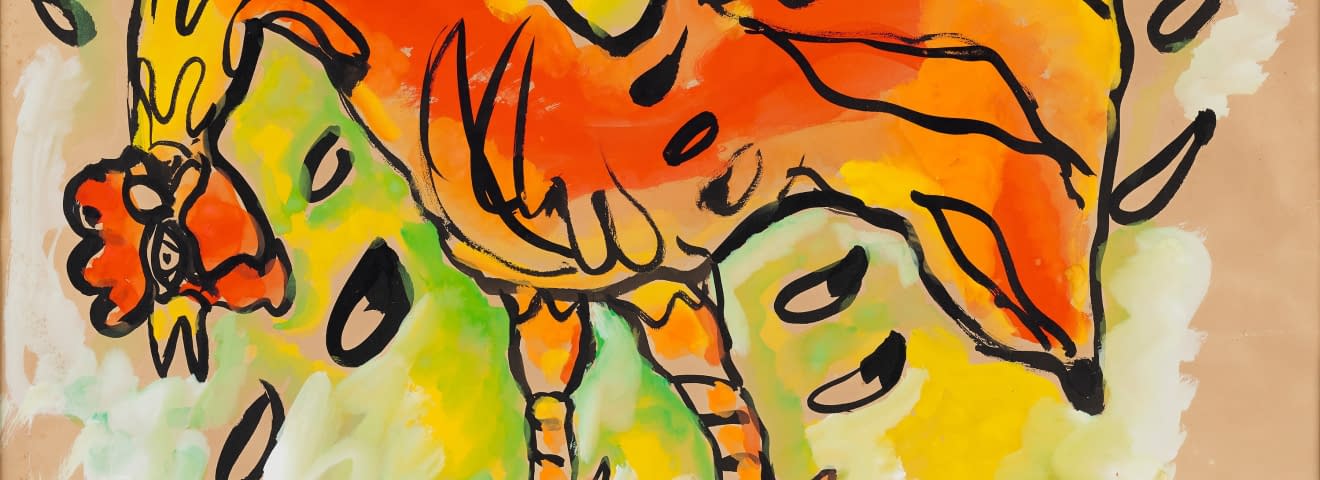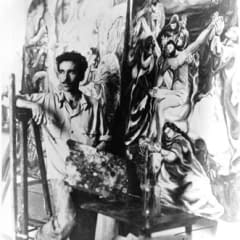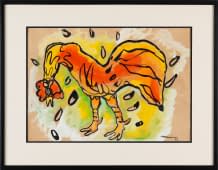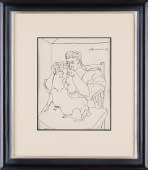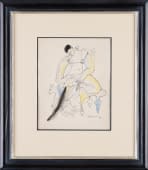José Mariano Manuel Rodríguez Álvarez
né(e) le 24. août 1912 à Havanna
décédé(e) le 26. mai 1990 à Havanna
Style artistique
À propos
Seine Mutter war Künstlerin und ermutigte ihn bereits in jungen Jahren, sich künstlerisch auszudrücken. 1928 schrieb er sich in der Kunstakademie San Alejandro ein, wo er Zeichen- und Modellierunterricht erhielt. 1936 reiste Rodriguez nach Mexiko und begann ein Studium an der Akademie San Carlos, wo Manuel Rodríguez Lozano sein Lehrer war. Hier studierte er die Freskotechnik und beschäftigte sich intensiv mit der Wandmalerei.
1937 kehrte er nach Kuba zurück und schon ein Jahr später nahm er an der II. Nationalen Ausstellung für Malerei und Bildhauerei teil. 1939 folgte die Teilnahme am Ersten Nationalen Künstlerkongress in Santiago de Cuba und seine erste Einzelausstellung.
Im Jahr 1941 führte Rodriguez den Hahn als Leitmotiv in seine Malerei ein. In diesem Jahr entstanden The Rooster (MoMA Collection, New York) und The Painted Rooster (Private Collection, Kalifornien). Der Hahn wurde für Rodriguez zu einem Symbol der kubanischen Identität, welches selbst in seine abstrakten Arbeiten immer wieder auftaucht. Ab 1944 reiste Rodriguez regelmässig nach New York, wo er in Galerien ausstellte und sich in den Museen der Kunstmetropole inspirieren liess.
Rodriguez nahm an zahlreichen internationalen Ausstellungen teil, so etwa im Museum of Modern Art, New York (1944), im Musée National D'Art Moderne, Paris (1951) oder im Museo de Bellas Artes de Caracas (1958). Seine Werke sind heute in Museen und Sammlungen auf der ganzen Welt vertreten.
Mariano Rodríguez was one of the most important figures in the second generation of the Cuban Avant-garde. His mother was an artist and encouraged his artistic expression at a young age. In 1928, he enrolled in the San Alejandro Academy of Art, where he received drawing and modelling lessons. In 1936, Rodriguez travelled to Mexico and began studying at the San Carlos Academy, where Manuel Rodríguez Lozano was his teacher. He studied the fresco technique and worked intensively on mural paintings.
In 1937, he returned to Cuba, participating in the II National Exhibition of Painting and Sculpture a year later. In 1939, he participated in the First National Congress of Artists in Santiago de Cuba and held his first solo exhibition. In 1941, Rodriguez introduced the rooster as a leading motif in his paintings. The same year he created The Rooster (MoMA Collection, New York) and The Painted Rooster (Private Collection, California). The rooster became a symbol of Cuban identity for Rodriguez, even appearing in his more abstract work. From 1944 onward, Rodriguez regularly travelled to New York, where he held exhibitions in galleries and found inspiration in the art metropolis’s museums.
Rodriguez was presented in numerous international exhibitions, such as the Museum of Modern Art, New York (1944), the Musée National D'Art Moderne, Paris (1951) and the Museo de Bellas Artes de Caracas (1958). His work is now on display in museums and collections around the world.
1937 kehrte er nach Kuba zurück und schon ein Jahr später nahm er an der II. Nationalen Ausstellung für Malerei und Bildhauerei teil. 1939 folgte die Teilnahme am Ersten Nationalen Künstlerkongress in Santiago de Cuba und seine erste Einzelausstellung.
Im Jahr 1941 führte Rodriguez den Hahn als Leitmotiv in seine Malerei ein. In diesem Jahr entstanden The Rooster (MoMA Collection, New York) und The Painted Rooster (Private Collection, Kalifornien). Der Hahn wurde für Rodriguez zu einem Symbol der kubanischen Identität, welches selbst in seine abstrakten Arbeiten immer wieder auftaucht. Ab 1944 reiste Rodriguez regelmässig nach New York, wo er in Galerien ausstellte und sich in den Museen der Kunstmetropole inspirieren liess.
Rodriguez nahm an zahlreichen internationalen Ausstellungen teil, so etwa im Museum of Modern Art, New York (1944), im Musée National D'Art Moderne, Paris (1951) oder im Museo de Bellas Artes de Caracas (1958). Seine Werke sind heute in Museen und Sammlungen auf der ganzen Welt vertreten.
Mariano Rodríguez was one of the most important figures in the second generation of the Cuban Avant-garde. His mother was an artist and encouraged his artistic expression at a young age. In 1928, he enrolled in the San Alejandro Academy of Art, where he received drawing and modelling lessons. In 1936, Rodriguez travelled to Mexico and began studying at the San Carlos Academy, where Manuel Rodríguez Lozano was his teacher. He studied the fresco technique and worked intensively on mural paintings.
In 1937, he returned to Cuba, participating in the II National Exhibition of Painting and Sculpture a year later. In 1939, he participated in the First National Congress of Artists in Santiago de Cuba and held his first solo exhibition. In 1941, Rodriguez introduced the rooster as a leading motif in his paintings. The same year he created The Rooster (MoMA Collection, New York) and The Painted Rooster (Private Collection, California). The rooster became a symbol of Cuban identity for Rodriguez, even appearing in his more abstract work. From 1944 onward, Rodriguez regularly travelled to New York, where he held exhibitions in galleries and found inspiration in the art metropolis’s museums.
Rodriguez was presented in numerous international exhibitions, such as the Museum of Modern Art, New York (1944), the Musée National D'Art Moderne, Paris (1951) and the Museo de Bellas Artes de Caracas (1958). His work is now on display in museums and collections around the world.
